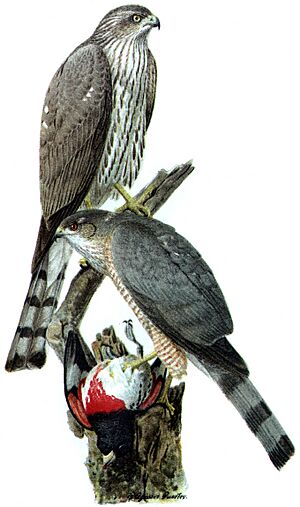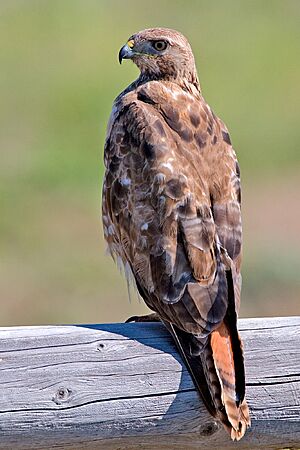Hawk facts for kids
Quick facts for kids Hawk |
|
|---|---|
 |
|
| Adult Eurasian goshawk | |
| Scientific classification | |
| Kingdom: | Animalia |
| Phylum: | Chordata |
| Class: | Aves |
| Order: | Accipitriformes |
| Family: | Accipitridae |

Hawks are amazing birds of prey. They belong to a big bird family called Accipitridae. You can find hawks almost everywhere on Earth, except for the icy continent of Antarctica.
There are many different kinds of hawks. Some are known as accipitrine hawks. These include birds like goshawks and sparrowhawks. They usually live in woodlands. These hawks have short, wide wings and long tails. They are very good at seeing things. They hunt by quickly darting out from a hidden spot.
Other hawks are called buteonine hawks. In places like the United States, these birds are simply called hawks. But in other parts of the world, they are known as buzzards. Buteonine hawks have broad wings and strong bodies. They are often larger than accipitrine hawks. They fly long distances in open areas. These hawks usually dive or pounce on their prey from above.
Sometimes, people use the term "hawk" for other birds too. For example, an osprey is sometimes called a "fish hawk." A peregrine falcon might be called a "duck hawk." This shows how common the name "hawk" is for many powerful hunting birds.

Contents
Amazing Hawks: Birds of Prey
Different Kinds of Hawks
Hawks are part of the Accipitridae family. This family also includes kites, harriers, and eagles. There are two main groups of hawks. These groups are the accipitrine hawks and the buteonine hawks.
Accipitrine Hawks: Woodland Hunters
Accipitrine hawks are often called "true hawks." They mostly hunt other birds. This is why some people call them "hen-hawks." They also live in woodlands, so they are sometimes called "wood-hawks." This group includes birds like sparrowhawks and goshawks. Sparrowhawks hunt small birds. Goshawks can hunt larger birds, even water-fowl.
Buteonine Hawks: Open Sky Flyers
The buteonine group includes well-known hawks like those in the Buteo genus. These birds are sometimes called "hawk-buzzards." They have strong bodies and wide wings. They are great at soaring high in open spaces. Unlike accipitrine hawks, they often hunt by diving down on their prey.
How Hawks See and Think
Super Sight: A Hawk's Vision
Hawks have incredible eyesight. They can see colors very well, even more than humans. This is because their eyes have special cells that detect many colors. Hawks can spot tiny prey from very high up. Their eyes have many light-sensing cells. These cells send strong signals to their brain. This helps them see details far away. Each hawk eye also has two special spots for sharp vision. This makes their view extra clear. Their eyeballs are shaped to give them a long-distance focus.
Smart Birds: Hawk Intelligence
Hawks are known to be very clever birds. In 2005, a scientist named Louis Lefebvre studied how birds find new ways to get food. He found that hawks are among the smartest birds. They can be very inventive when it comes to hunting.
Traveling Far: Hawk Migration
Many hawks travel long distances. They migrate twice a year, in autumn and spring. The autumn journey starts in August and finishes by mid-December. Different hawk species leave at different times. Hawks that travel further often leave earlier in autumn. Those with shorter trips start later. Arriving early helps hawks find the best mates and places to live. They also get first choice of food.
Many things affect a hawk's migration. Hawks need enough body fat to fuel their long flights. The more fat they have, the safer their journey. Their flight path is also very important. Strong winds can help push them along. But bad winds can blow them off course. Hawks usually avoid flying over large bodies of water. This is because air conditions can be unpredictable there. They prefer to fly around lakes or along coastlines.
You can help scientists learn about hawk migration. This is called Hawkwatching. People watch and count hawks as they fly by. This data helps us understand these amazing birds better.
Where Hawks Live Around the World
Hawks are very adaptable birds. They can live in many different places. The red-tailed hawk is a very common hawk in North America. Hawks often prefer open areas like deserts and fields. This makes it easier for them to spot their prey. You can also find them in mountains and tropical places. They live in areas like Central America, the West Indies, and Jamaica.
Daily Life: Hawk Behavior
Young hawks are fed by their parents. They stay in the nest until they are about six weeks old. After leaving the nest, they are called fledglings. They learn to hunt as they get older. Like most birds of prey, hawks use their strong talons to catch and kill their prey. Hawks often hunt just before nightfall. They fly by flapping their wings fast. Then they glide through the air using the air currents. When many hawks migrate together, they form groups. These groups are sometimes called "kettles." Traveling in groups helps them survive better.
Life Cycle: How Hawks Reproduce
Hawks have interesting ways of finding partners and raising their young. Some hawk species stay with one partner for their entire lives. They are called monogamous. A male and female hawk will build their nest together. They improve it throughout the nesting season. This usually happens before they mate.
Hawks have a special mating ritual. First, the male and female fly together in circles. They fly higher and higher. Then, the male dives quickly towards the female. He then flies back up to the same height. They repeat this dance. Finally, the male latches onto the female. They then free-fall towards the ground together.
A female hawk usually lays about five eggs each year. Both parents guard and care for the eggs. They do this for about a month until the eggs hatch.
What Hawks Eat
Hawks eat many different small animals. Their diet includes snakes, lizards, fish, mice, rabbits, and squirrels. They also hunt other birds. Some hawks, like red-shouldered hawks, eat smaller birds such as doves. They also enjoy insects like grasshoppers and crickets. Hawks are skilled hunters. They catch any small game they find on the ground.
Hawks in Our Culture
Hawks have been important to humans for a long time. The sport of falconry was once called "hawking." Any bird used for this sport was called a hawk.
Hawks in Sports and Symbols
Hawks are often used as symbols for strength and speed. Many sports teams use the hawk as their emblem. Examples include the Atlanta Hawks and the Hawthorn Hawks. The sports teams at Miami University are called the Miami RedHawks. Saint Joseph's University also uses the Hawk as its symbol. The University of Iowa teams are known as the Iowa Hawkeyes. Their mascot is Herky the Hawk.
Hawks in History and Art
In politics, the term war hawk describes someone who favors going to war. This term started in the United States in 1810. It was used during debates about a possible war with Great Britain. Congressman John Randolph used it for Henry Clay's group. People who are against war are called "doves."
Hawks are very special to the Sikh community. They are strongly linked to Guru Gobind Singh. He was believed to have a white Northern goshawk. Because of this, the Northern Goshawk became the official state bird of Punjab, India.
In Korea, during the early Joseon period, hawks were seen as symbols of courage and justice. Artists like Chŏng Hongnae painted hawks for royalty. His painting Hawk at Sunrise is now in a famous museum.

